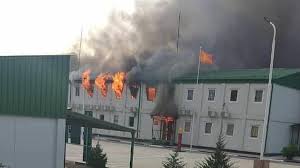Kyrgyzstan-Tajikistan Conflict Was Also About the Flow of Afghani Narcotics

All Global Research articles can be read in 51 languages by activating the “Translate Website” drop down menu on the top banner of our home page (Desktop version). Visit and follow us on Instagram at @crg_globalresearch.
***
Recent border clashes between Kyrgyzstan and Tajikistan claimed more than 40 lives, most of them civilians. Although the dispute may seem like another post-Soviet conflict over population and territory, it is also motivated by water control and drug trafficking. The skirmishes between April 28 and May 1 were the worst border clashes between the two Central Asian countries in thirty years and had the potential to spiral out of control.
Kyrgyzstan’s southwest Batken region, the location of the brief conflict, is wedged by Tajikistan and Uzbekistan to its north, and solely by Tajikistan to its west and south. The region also has six enclaves, four belonging to Uzbekistan and two to Tajikistan.
What started off as stone throwing between Tajik and Kyrgyz locals in Batken province, especially around the Tajik enclave of Vorukh, eventually degenerated into a pitched battle with the involvement of the two countries militaries.
On April 29, a ceasefire was signed to put an end to the violence, however, without success. The heads of the Security Committees then signed a protocol on the delimitation of the border on May 2. A spokesperson for the Kyrgyz Committee announced that “no incident and no shooting have been reported” and described the border as “quiet, peaceful and calm,” suggesting the violence has ended.
Sharing a 971-kilometer border, of which more than a third is disputed and has little demarcation, Kyrgyzstan and Tajikistan have a turbulent history. However, the origin of these clashes is linked with the March 26 agreement between Kyrgyzstan and Uzbekistan to settle the fate of Sokh, an Uzbek enclave completely surrounding by Kyrgyzstan but almost exclusively populated by Tajiks.
The agreement between Uzbekistan and Kyrgyzstan allowed for easier movement between the Sokh enclave and the Uzbek mainland, essentially creating a new corridor through Central Asia. The easing of travel to and from the enclave means that narcotics and other contraband, which pass through Vorukh in great volume, can now pass through Sokh instead. Effectively, rival criminal networks in Central Asia can bypass Tajikistan now.
Afghanistan, a drug hub that produces 80% of the world’s opium, is located south of Tajikistan and is the crossroads of Central Asia, strategic for China’s Belt and Road Initiative, and close to the fertile Ferghana Valley. Although commentators believe that the fighting is solely over water facilities in territory claimed by both Kyrgyzstan and Tajikistan, it is also part of controlling narcotic flows.
A United Nations report found that approximately 85% of opiates trafficked through Central Asia in 2010 passed through Tajikistan. This accounted for the estimated 15% of opiates and 20% of heroin produced in Afghanistan that is smuggled through the northern route in Central Asia. Although it borders Afghanistan, Uzbekistan receives the bulk of its heroin via Tajikistan before it is trafficked into Kazakhstan.
Drug trafficking through Tajikistan generated an estimated $2.7 billion per year in 2011, possibly surpassing any legitimate source of wealth in the country. The Diplomat explains that during the Tajik Civil War, the drug trade was one of the major sources of income for both government and opposition commanders, and when the war ended in 1997, drug trafficking became a shadow part of the peace process, with commanders on both sides of the conflict receiving positions in the government and cooperating to extract rent through personal criminal networks. This led to many high-ranking Tajik state officials becoming top bosses in criminal networks centered on protection racketeering and drug trafficking. However, as The Diplomat pointed out, although Tajik President Emomali Rahmon engaged with the U.S. to fight against drug trafficking, counternarcotic policies have been used by him to dismantle the post-civil war political bargain, centralize power around his clan-based inner circle, and consolidate control of the drug trade.
According to former French colonel René Cagnat, a specialist in Central Asia and the post-Soviet space, by Uzbekistan and Kyrgyzstan agreeing over the Sokh enclave status, drug flows from Afghanistan “which passed through Vorukh, will now pass more or less clandestinely through Sokh.” For Tajikistan, the brief conflict with Kyrgyzstan was not only a territorial dispute with concern for water access, but also to ensure the flow of Afghani drugs and other contraband continues to pass through Vorukh instead of Sokh to eventually reach Russia and Western Europe.
Kyrgyz President Sadyr Japarov proposed on May 2 to create a “peacekeeping commission” made up of Kyrgyz and Tajik community elders in the disputed area “in order to prevent new conflicts.” Despite the clashes, contacts between the two countries were maintained to calm the situation. Japarov and Rahmon have called each other twice and have agreed to meet soon, suggesting that this conflict, as brief as it was, has come to an end and will likely reach a peaceful compromise, as recently happened between Kyrgyzstan and Uzbekistan – but the narcotics will continue to flow.
*
Note to readers: Please click the share buttons above or below. Follow us on Instagram, @crg_globalresearch. Forward this article to your email lists. Crosspost on your blog site, internet forums. etc.
Paul Antonopoulos is an independent geopolitical analyst.
Featured image is from InfoBrics

